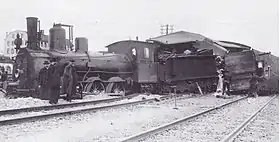Bavarian C IV
The C IV was a steam locomotive, built for goods train duties, that was manufactured between 1884 and 1897 for the Royal Bavarian State Railways (Königlich Bayerische Staatsbahn).
| C IV Zwilling (two-cylinder simple) DRG Class 53.80 | |
|---|---|
| Number(s) |
|
| Quantity | 87 |
| Manufacturer | |
| Year(s) of manufacture | 1884–1892 |
| Retired | by 1926 |
| Wheel arrangement | 0-6-0 |
| Axle arrangement | C n2 |
| Track gauge | 1,435 mm (4 ft 8 1⁄2 in) |
| Length over buffers | 14,600 mm (47 ft 10 3⁄4 in) |
| Wheelbase incl. tender | 10,300 mm (33 ft 9 1⁄2 in) |
| Service weight | 40.0 t (39.4 long tons; 44.1 short tons) |
| Adhesive weight | 40.0 t (39.4 long tons; 44.1 short tons) |
| Axle load | 13.3 t (13.1 long tons; 14.7 short tons) |
| Top speed | 50 km/h (31 mph) |
| Driving wheel diameter | 1,340 mm (4 ft 4 3⁄4 in) |
| Valve gear | Allan, inside |
| No. of cylinders | 2, simple |
| Cylinder bore | 486 mm (19 1⁄8 in) |
| Piston stroke | 630 mm (24 13⁄16 in) |
| Boiler Overpressure | 11 kgf/cm2 (1,080 kPa; 156 lbf/in2) |
| Grate area | 1.67 m2 (18.0 sq ft) |
| Evaporative heating area | 111.80 m2 (1,203.4 sq ft) |
| Tender | 3 T 10.2 |
| Tender service weight | 27.2 t (26.8 long tons; 30.0 short tons) |
| Water capacity | 10.2 m3 (2,200 imp gal; 2,700 US gal) |
| Fuel | 5,000 kg (11,000 lb) coal |
| C IV Verbund (two-cylinder compound) DRG Class 53.80–81 | |
|---|---|
 Bavarian C IV no. 1536 after a derailment in Munich Laim station in 1908 | |
| Number(s) |
|
| Quantity | 100 |
| Manufacturer |
|
| Year(s) of manufacture | 1889–1897 |
| Retired | by 1931 |
| Wheel arrangement | 0-6-0 |
| Axle arrangement | C n2v |
| Track gauge | 1,435 mm (4 ft 8 1⁄2 in) |
| Length over buffers |
|
| Wheelbase incl. tender |
|
| Service weight |
|
| Adhesive weight |
|
| Axle load |
|
| Top speed | 50 km/h (31 mph) |
| Driving wheel diameter | 1,340 mm (4 ft 4 3⁄4 in) |
| Valve gear | Allan, inside |
| No. of cylinders | 2, compound |
| LP cylinder bore | 705 mm (27 3⁄4 in) |
| HP cylinder bore |
|
| Piston stroke | 630 mm (24 13⁄16 in) |
| Boiler Overpressure |
|
| Grate area | 1.67 m2 (18.0 sq ft) |
| Evaporative heating area | 111.80 m2 (1,203.4 sq ft) |
| Tender | 3 T 10.5 |
| Tender service weight | 27.5 t (27.1 long tons; 30.3 short tons) |
| Water capacity | 10.5 m3 (2,300 imp gal; 2,800 US gal) |
| Fuel | 5,000 kg (11,000 lb) coal |
| |
Description
Between 1884 and 1893 a total of 87 units two-cylinder, saturated steam engines were delivered. They were followed by two compound engines in 1889 for testing and then 98 more compounds from 1892 to 1897. The locomotives, which for the first time did not have the external frames typical in Bavaria up to that time, were soon no longer equal to the growing demands made on them. In spite of that, many were taken over by the Deutsche Reichsbahn, designated as Class 53.80-81 and allocated the operating numbers 53 8011 to 8064 and 53 8081 to 8168. The two-cylinder engines were equipped with a Bavarian Class 3 T 10.2 tender; they were all retired by 1926. The compound variants had a Class 3 T 10.5 tender; they were taken out of service by 1931.[1]
References
- Horst J. Obermayer (1995) [1990 Franckh-Kosmos Stuttgart], Dampflokomotiven Regelspur (in German), Augsburg: Weltbild, p. 117, ISBN 3-89350-819-8